AUDI TT COUPE 2016 Owners Manual
Manufacturer: AUDI, Model Year: 2016, Model line: TT COUPE, Model: AUDI TT COUPE 2016Pages: 322, PDF Size: 52.86 MB
Page 211 of 322
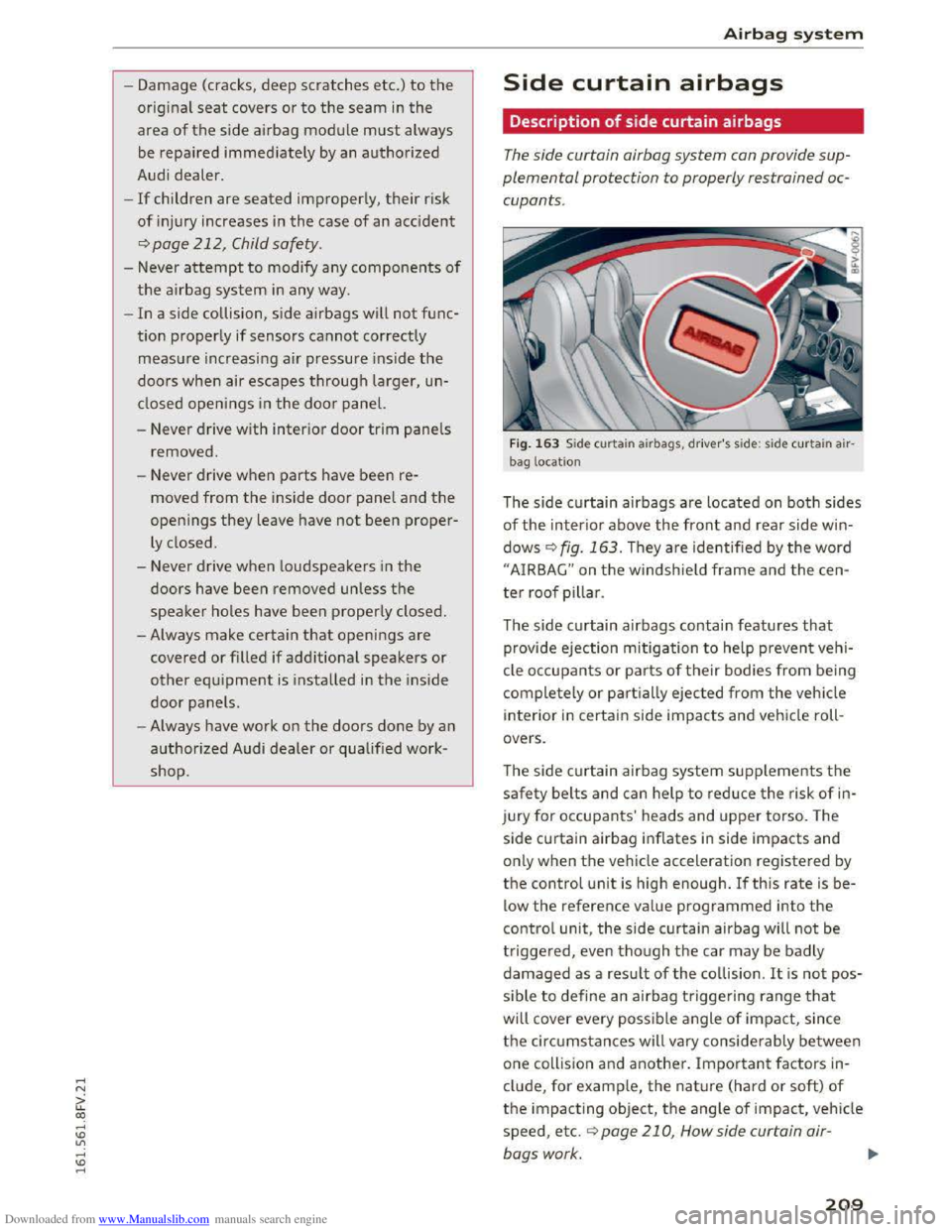
Downloaded from www.Manualslib.com manuals search engine ..... N
G: CX)
.....
"' U"I
.....
"' .....
-Damage (cracks, deep scratches etc.) to the
original seat covers or to the seam in the
area of the side airbag module must always
be repaired immediately by an authorized
Audi dealer.
-If children are seated improperly, their risk
of injury increases in the case of an accident
¢page 212, Child safety.
-Never attempt to modify any components of
the airbag system in any way.
-
In a side collision, side airbags will not func
tion properly if sensors cannot correctly
measure increasing air pressure inside the
doors when air escapes through larger, un
closed openings in the door panel.
-Never drive with interior door trim panels
removed.
-Never drive when parts have been re
moved from the inside door panel and the
openings they leave have not been proper
ly closed.
- Never drive
when loudspeakers in the
doors have been removed unless the
speaker holes have been properly closed.
- Always
make certain that openings are
covered or filled if additional speakers or
other equipment is installed in the inside
door panels.
-Always have work on the doors done by an
authorized Audi dealer or qualified work
shop.
Airbag system
Side curtain airbags
Description of side curtain airbags
The side curtain airbag system can provide sup
plemental protection to properly restrained oc
cupants.
Fig. 163 Side curtain airbags, driver's side: side curtain air
bag locat ion
The side curtain airbags are located on both sides
of the interior above the front and rear side win
dows~ fig. 163. They are identified by the word
"AIRBAG" on the windshield frame and the cen
ter roof pillar .
The
side curtain airbags contain features that
provide ejection mitigation to help prevent vehi
cle occupants or parts of their bodies from being
completely or partially ejected from the vehicle
interior in certain side impacts and vehicle roll
overs.
The
side curtain airbag system supplements the
safety belts and can help to reduce the risk of in
jury for occupants' heads and upper torso. The
side
curtain airbag inflates in side impacts and
only when the vehicle acceleration registered by
the control unit is high enough. If this rate is be
low the reference value programmed into the
control unit, the side curtain airbag will not be
triggered, even though the car may be badly
damaged as a resu lt of the collision. It is not pos
sible to define an airbag triggering range that
will cover every possible angle of impact, since
the circumstances will vary considerably between
one collis ion and another. Important factors in
clude, for example, the nature (hard or soft) of
the impacting object, the angle of impact, vehicle
speed, etc. ~page 210, How side curtain air
bags work .
209
Page 212 of 322
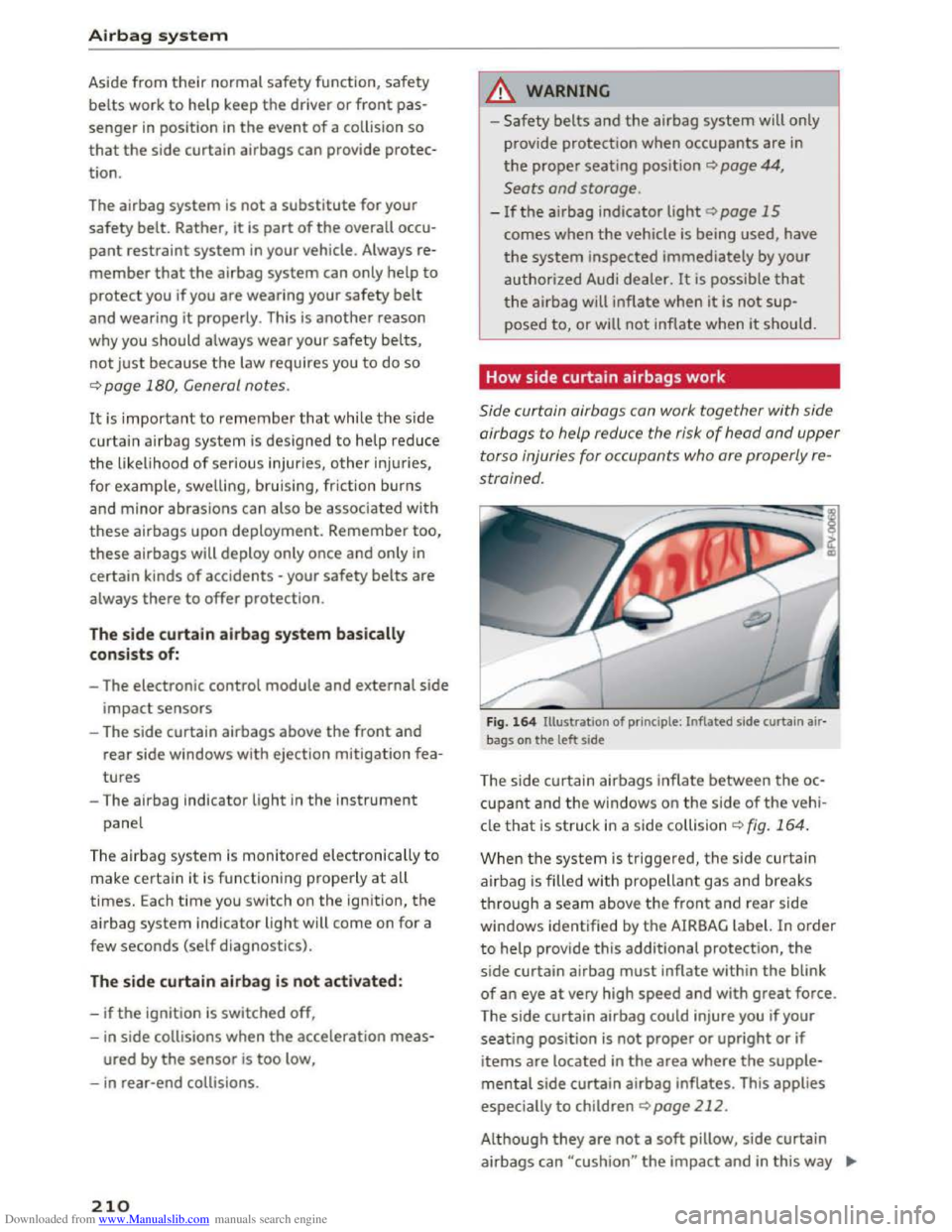
Downloaded from www.Manualslib.com manuals search engine Airbag sy stem
Aside from their normal safety function, safety
belts work to help keep the driver or front pas
senger in position in the event of a collision so
that the side curtain airbags can provide protec
tion .
The airbag
system is not a substitute for your
safety belt. Rather, it is part of the overall occu
pant restraint system in your vehicle. Always re
member that the airbag system can only help to
protect you if you are wearing your safety belt
and wearing it properly . This is another reason
why you
should always wear your safety belts,
not just because the law requires you to do so
~page 180, General notes.
It is important to remember that while the side
curtain a irbag system is designed to help reduce
the likelihood of serious injuries, other injuries,
for
example, swelling, bruising, friction burns
and minor abrasions can also be associated with
these airbags upon deployment. Remember too,
these airbags will deploy only once and only in
certain kinds of accidents -your safety belts are
always there to offer protection.
The side curta in airbag sy stem basically
consists
of:
-The electronic control module and external side
impact sensors
-The side curtain airbags above the front and
rear side windows with ejection mitigation fea
tures
-The airbag indicator light in the instrument
panel
The airbag system is monitored electronically to
make certain it is function ing properly at all
times. Each time you switch on the ignition, the
airbag system indicator light will come on for a
few seconds (self diag nasties).
The side curtain airbag is not activated:
-if the ignition is switched off,
-
in side collisions when the acceleration meas-
ured by the sensor is too low,
- in
rear-end collisions .
210
A WARNING
-Safety belts and the airbag system will only
provide
protection when occupants are in
the proper seating position Q page 44,
Seats and storage.
-If the airbag indicator light Q page 15
comes when the vehicle is being used, have
the system inspected immediately by your
authorized Audi dealer. It is possible that
the airbag will inflate when it is not sup
posed to, or will not inflate when it should.
How side curtain airbags work
Side curtain airbags can work together with side
airbags to help reduce
the risk of head and upper
t orso injuries for occupants who are properly re
strained.
Fig. 164 Illustration of principle: Inflated side curtain air
bags on
the left side
The side curtain airbags inflate between the oc
cupant and the windows on the side of the vehi
cle
that is struck in a side collision Q fig. 164.
When the system is triggered, the s ide curtai n
airbag
is filled with propellant gas and breaks
th rough a seam above the front and rear side
windows identified by the AIRBAG label. In order
to help provide this additional protection, the
side curtain airbag must inflate within the blink
of an eye at very high speed and with great force .
The
side curtain airbag could injure you if your
seating position is not proper or upright or if
items are located in the area where the supple
mental side curtain airbag inflates. This applies
especially to children Qpage 212.
Although they are not a soft pillow, side curtain
airbags can "cushion" the impact and in this way .,..
Page 213 of 322
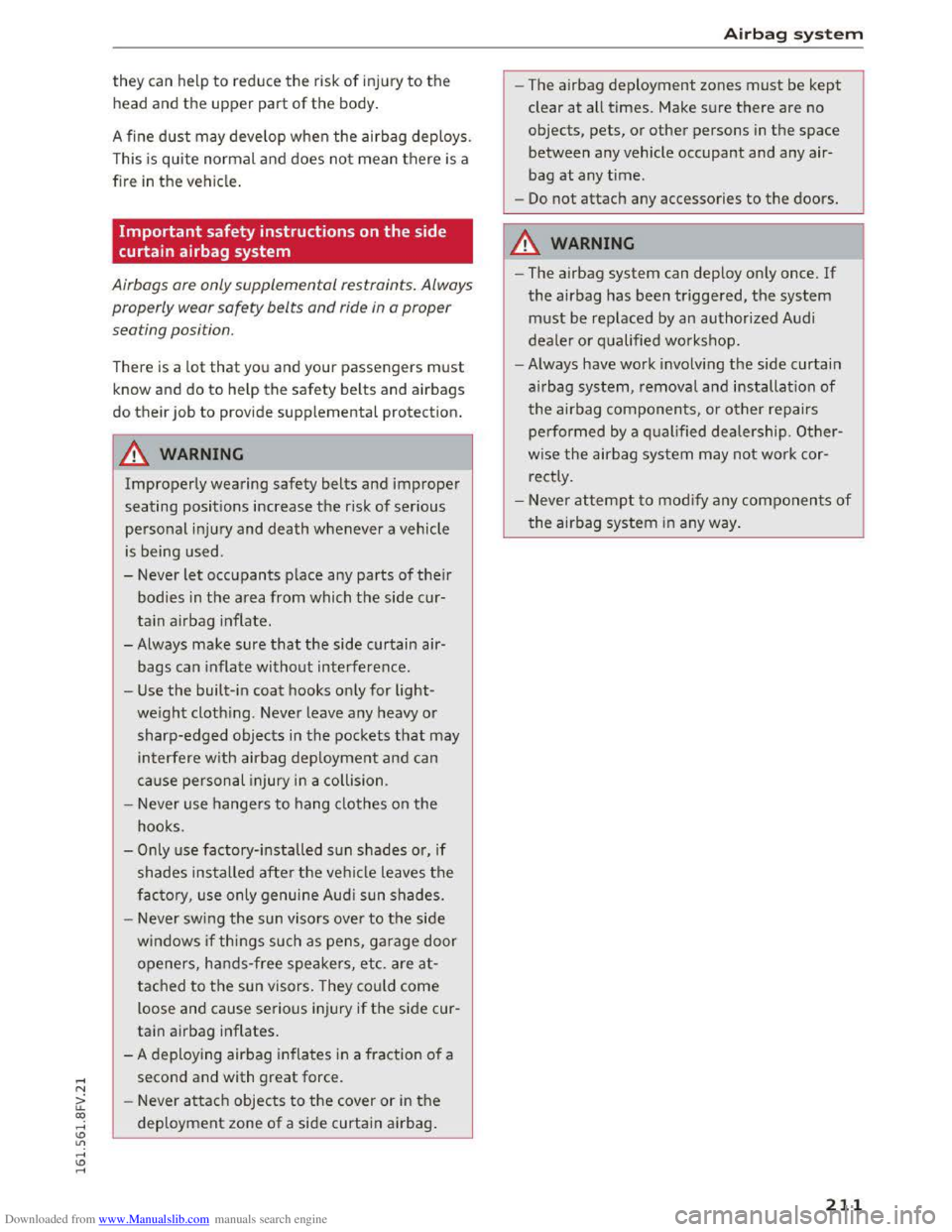
Downloaded from www.Manualslib.com manuals search engine they can help to reduce the risk of injury to the
head and the upper part of the body.
A fine
dust may develop when the airbag deploys.
This is
quite normal and does not mean there is a
fire
in the vehicle.
Important safety instructions on the side
curtain airbag system
Airbags are only supplemental restraints. Always
properly wear safety belts and ride in a proper
seating position.
There is a lo t that you and your passengers must
know and do to help the safety belts and airbags
do their job to provide supplemental protection.
A WARNING
Improperly wearing safety belts and improper
seating positions increase the risk of serious
personal injury and death whenever a vehicle
is being
used.
-Never let occupants place any parts of their
bodies in the area from which the side cur
tain airbag inflate.
-Always make sure that the side curtain air
bags can inflate without interference.
-Use the built-in coat hooks only for light
weight clothing . Never leave any heavy or
sharp-edged objects in the pockets that may
interfere with airbag deployment and can
cause personal injury in a collision.
-Never use hangers to hang clothes on the
hooks.
- Only use factory-installed sun shades or, if
shades installed after the vehicle leaves the
factory, use only genuine Audi sun shades.
-Never swing the sun visors over to the side
windows if things such as pens, garage door
openers, hands-free speakers, etc. are at
tached to the sun visors. They could come
loose and cause serious injury if the side cur
tain airbag inflates.
-A deploying airbag inflates in a fraction of a
second and with great force.
-Never attach objects to the cover or in the
deployment zone of a side curtain airbag.
Airbag system
-The airbag deployment zones must be kept
clear at all times. Make sure there are no
objects,
pets, or other persons in the space
between any vehicle occupant and any air
bag
at any time.
-Do not attach any accessories to the doors.
A WARNING
~
-The airbag system can deploy only once. If
the airbag has been triggered, the system
must be replaced by an authorized Audi
dealer or qualified workshop.
-Always have work involving the side curtain
airbag
system, removal and installation of
the airbag components, or other repairs
performed by a qualified dealership. Other
wise the airbag system may not work cor
rectly.
-Never attempt to modify any components of
the airbag system in any way.
211
Page 214 of 322
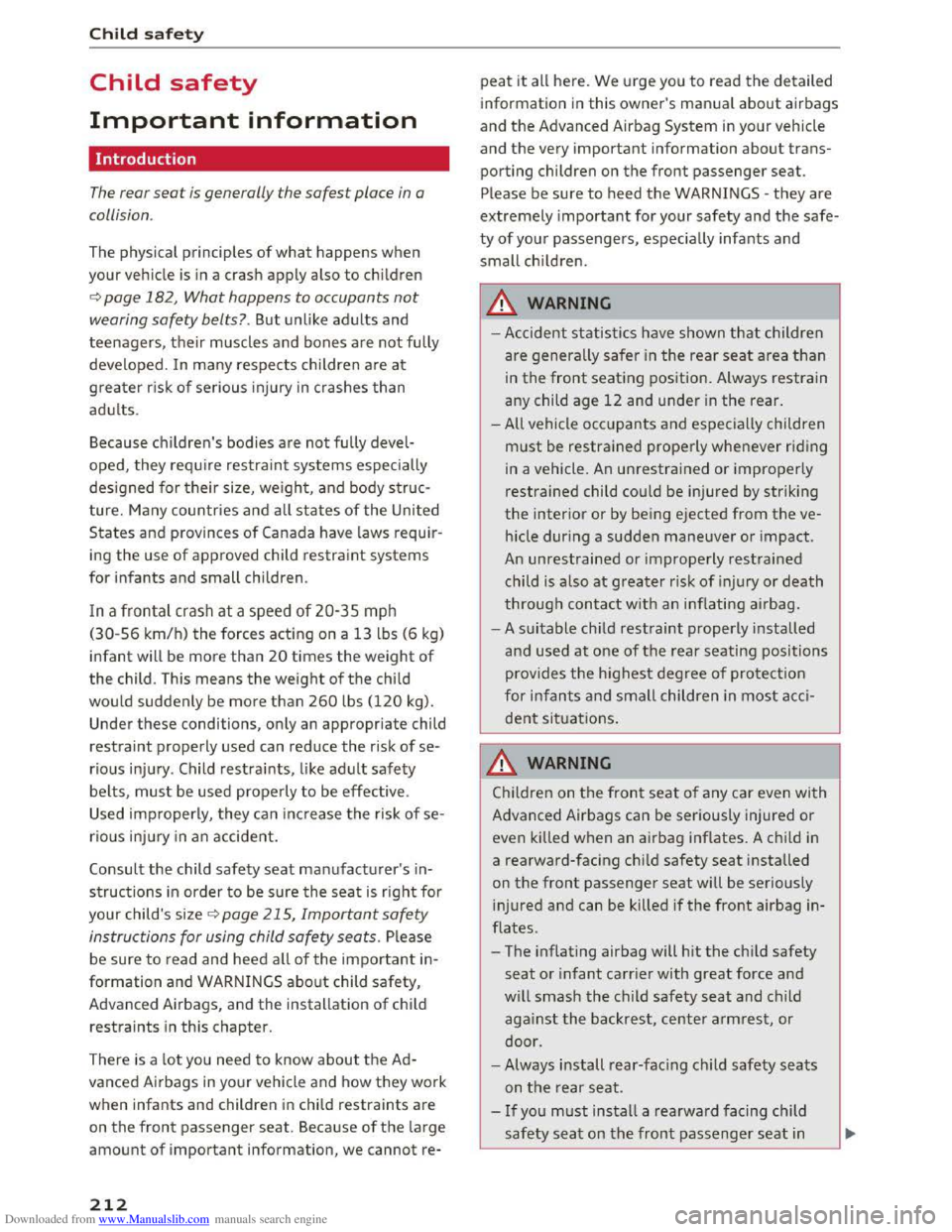
Downloaded from www.Manualslib.com manuals search engine Child safety
Child safety
Important information
Introduction
The rear seat is generally the safest place in a
collision .
The physical principles of what happens when
your vehicle is in a crash apply also to children
¢page 182, What happens to occupants not
wearing safety belts? . But unlike adults and
teenagers, their muscles and bones are not fully
developed. In many respects children are at
greater risk of serious injury in crashes than
adults.
Because children's
bodies are not fully devel
oped, they require restraint systems especially
designed for their size, weight, and body struc
ture. Many countries and all states of the United
States and provinces of Canada have laws requir
ing
the use of approved child restraint systems
for infants and small children .
In a frontal crash at a speed of 20-35 mph
(30-56 km/h) the forces acting on a 13 lbs (6 kg)
infant will be more than 20 times the weight of
the child. This means the weight of the child
would
suddenly be more than 260 lbs (120 kg).
Under these conditions, only an appropriate child
restraint properly used can reduce the risk of se
rious injury .
Child restraints, like adult safety
belts, must be used properly to be effective .
Used improperly, they can increase the risk of se
rious injury in an accident.
Consult the child safety seat manufacturer's in
structions in order to be sure the seat is right for
your child's size¢ page 215, Important safety
instructions for using child safety seats. Please
be sure to read and heed all of the important in
formation and WARNINGS about child safety,
Advanced Airbags, and the installation of child
restraints in this chapter.
There is a lot you need to know about the Ad
vanced Airbags in your vehicle
and how they work
when infants and children in child restraints are
on the front passenger seat. Because of the large
amount of important information, we cannot re-
212
peat it all here. We urge you to read the detailed
information in this owner's manual about airbags
and the Advanced Airbag System in your vehicle
and the very important information about trans
porting children on the front passenger seat.
Please be sure to heed the WARNINGS -they are
extremely important for your safety and the safe
ty of your passengers, especially infants and
small children.
.&_WARNING
-Accident statistics have shown that children
are generally safer in the rear seat area than
in the front seating position. Always restrain
any child age 12 and under in the rear.
-
All vehicle occupants and especially children
must be restrained properly whenever riding
in a vehicle.
An unrestrained or improperly
restrained child could be injured by striking
the interior or by being ejected from the ve
hicle
during a sudden maneuver or impact.
An unrestrained or improperly restrained
child is also at greater risk of injury or death
through contact with an inflating airbag.
-A suitable child restraint properly installed
and used at one of the rear seating positions
provides the highest degree of protection
for infants and small children in most acci
dent situations.
.&_WARNING
Children on the front seat of any car even with
Advanced Airbags can be seriously injured or
even killed when an airbag inflates. A child in
a
rearward-facing child safety seat installed
on the front passenger seat will be seriously
injured and can be killed if the front airbag in
flates.
-The inflating airbag will hit the child safety
seat or infant carrier with great force and
will smash the child safety seat and child
against the backrest, center armrest, or
door.
-Always install rear-facing child safety seats
on the rear seat.
-
If you must install a rearward facing child
safety seat on the front passenger seat in
Page 215 of 322

Downloaded from www.Manualslib.com manuals search engine ..... N
G'. CX)
..... ID IJ' ..... ID .....
exceptional circumstances and the
PASSENGER AIR BAG OFF light does not
come on and stay on, immediately install
the rear-facing child safety seat in a rear
seating position and have the airbag system
inspected immediately by your Audi dealer.
A WARNING
-Forward-facing child seats installed on the
front passenger seat may interfere with the
deployment of the airbag and cause serious
personal injury to the child.
-If exceptional circumstances require the use
of a forward-facing child restraint on the
front passenger's seat, the child's safety
and well-being require the following special
precautions to be taken:
-Always make sure that the forward-facing
seat has been designed and certified by its
manufacturer for use on a front passenger
seat with a front and side airbag.
- Always carefully follow
the manufacturer's
instructions provided with the child seat
or infant carrier.
- Never install a child
restraint without a
properly
attached top tether strap if the
child restraint manufacturer's instructions
require the top tether strap to be used.
- Never
put the forward-facing child re
straint up against or very near the instru
ment panel.
- Always move
the passenger seat into its
rearmost position in the seat's fore and
aft adjustment range, as far away from
the airbag as possible before installing the
child restraint. The backrest must be ad
justed to an upright position.
- Always
make sure that nothing prevents
the front passenger's seat from being
moved
to the rearmost position in its fore
and aft adjustment range.
- Never place objects on the seat (such as a
laptop, CD player, electronic games de
vice, power inverter or seat heater for
child
seats). These may influence the elec
trical
capacitance measured by the capaci
tive
passenger detection system and can
Child safety
also fly around in an accident and cause
serious personal injury.
- Never place
or use any electrical device
(such as a
laptop, CD player, electronic
games device, power inverter or seat heat
er for child seats) on the front passenger
seat if the device is connected to the 12-
volt socket or the cigarette lighter socket.
-
If a seat heater has been retrofitted or
otherwise added to the front passenger
seat, never install any child restraint sys
tem on this seat.
-Make sure that there are no wet objects
(such as a wet towel) and no water or oth
er liquids on the front passenger seat
cushion.
- Always
make sure that the PASSENGER
AIR BAG OFF light comes on and stays on
a ll
the time whenever the ignition is
switched on.
-If the PASSENGER AIR BAG OFF light
does not come on and stay on, immediate
ly install the forward-facing child seat in a
rear seating position and have the airbag
system inspected by your authorized Audi
dealer.
- Always buckle
the child seat firmly in
place even if a child is not sitting in it. A
loose child seat can fly around during a
sudden stop or in a collision.
- Always read
and heed all WARNINGS
whenever using a child restraint in a vehi
cle
c> page 180, Safety belts, c> page 188,
Airbag system
and ~page 212, Impor
tant information .
(D Tips
Always replace child restraints that were in
stalled in a vehicle during a crash. Damage to
a child restraint that is not visible could cause
it to fail in another collision situation.
Advanced front airbag system and children
Your vehicle is equipped with a front "Advanced
Airbag System" in compliance with United States
Federal Motor Vehicle Safety Standard (FMVSS) ~
213
Page 216 of 322
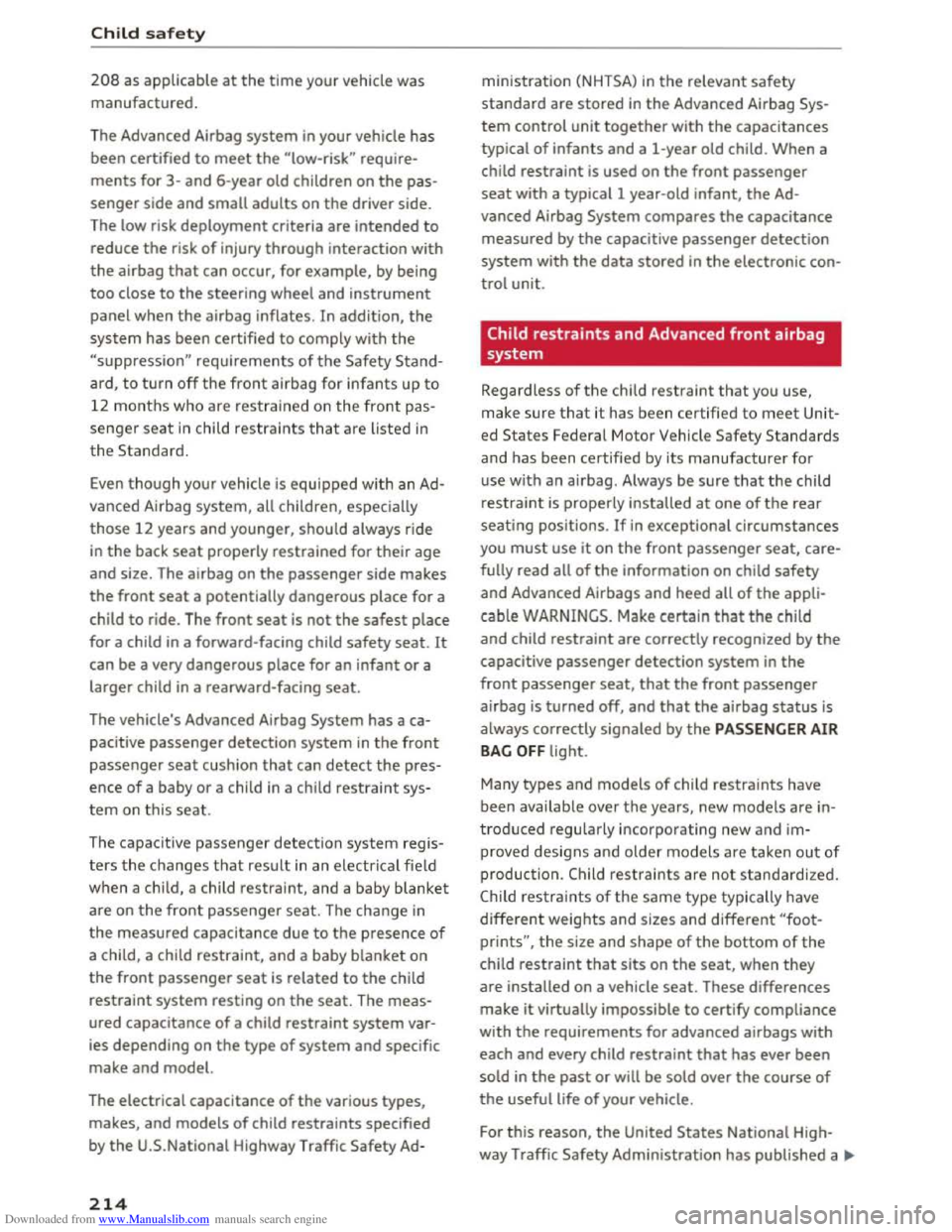
Downloaded from www.Manualslib.com manuals search engine Child safety
208 as applicable at the time your vehicle was
manufactured.
The Advanced Airbag system in your vehicle has
been certified to meet the "low-risk" require
ments for 3-and 6-year old children on the pas
senger side and small adults on the driver side.
The low risk deployment criteria are intended to
reduce the risk of injury through interaction with
the airbag that can occur, for example, by being
too close to the steering wheel and instrument
panel when the airbag inflates. In addition, the
system has been certified to comply with the
"suppression" requirements of the Safety Stand
ard, to turn off the front airbag for infants up to
12 months who are restrained on the front pas
senger seat in child restraints that are listed in
the Standard.
Even though your vehicle is equipped with an Ad
vanced Airbag
system, all children, especially
those 12 years and younger, should always ride
in the back seat properly restrained for their age
and size. The airbag on the passenger side makes
the front seat a potentially dangerous place for a
child
to ride. The front seat is not the safest place
for a child
in a forward-facing child safety seat. It
can be a very dangerous place for an infant or a
larger child in a rearward-facing seat.
The vehicle's Advanced Airbag System has a ca
pacitive
passenger detection system in the front
passenger seat cushion that can detect the pres
ence of a baby or a child in a ch ild restraint sys
tem on this seat.
The capacitiv e passenger detection system regis
ters the changes that resul t in an electrical field
when a ch ild , a child restraint, and a baby blanket
are on the front passenger seat. The change in
the measured capacitance due to the presence of
a child, a child restraint, and a baby blanket on
the front passenger seat is related to the child
restraint system resting on the seat. The meas
ured capacitance of a child restraint system var
ies
depending on the type of system and specific
make and model.
The electrical capacitance of the various types,
makes, and models of child restraints specified
by
the U.S.National Highway Traffic Safety Ad-
214
ministration (NHTSA) in the relevant safety
standard are stored in the Advanced Airbag Sys
tem control unit together with the capacitances
typical of infants and a 1-year old child. When a
child
restraint is used on the front passenger
seat with a typical 1 year-old infant, the Ad
vanced Airbag
System compares the capacitance
measured by the capacitive passenger detection
system with the data stored in the electronic con
trol unit.
Child restraints and Advanced front airbag
system
Regardless of the child restraint that you use,
make sure that it has been certified to meet Unit
ed States Federal Motor Vehicle Safety Standards
and ha s been certified by its manufacture r for
use with a n airbag. Always be sur e that the child
restraint is properly installed at one of the rear
seating positions. If in exceptional circumstances
you must use it on the front passenger seat, care
fully
read all of the information on child safety
and Advanced Airbags and heed all of the appli
cable WARNINGS. Make certain that the child
and child restraint are correctly recognized by the
capacitive passenger detection system in the
front passenger seat, that the front passenger
airbag is turned off, and that the airbag status is
always correctly si
gnaled by the PASSENGER AI R
BAG OFF light.
Many types and models of child restraints have
been available over the years, new models are in
troduced regularly incorporating new and im
proved
designs a nd older models are taken out of
production. Child restraints are not standardized .
Child
restraints of the same type typically have
different weights and sizes and different "foot
pr ints", the size and shape of the bottom of the
child restraint that sits on the seat, when they
are installed on a vehicle seat. These differences
make it virtually impossible to certify compliance
with the requirements for advanced airbags with
each
and every child restraint that has ever been
sold in the past or will be sold over the course of
the useful life of your vehicle.
For
this reason, the United States Nat ional High
way Traffic
Safety Administration has published a ..,_
Page 217 of 322
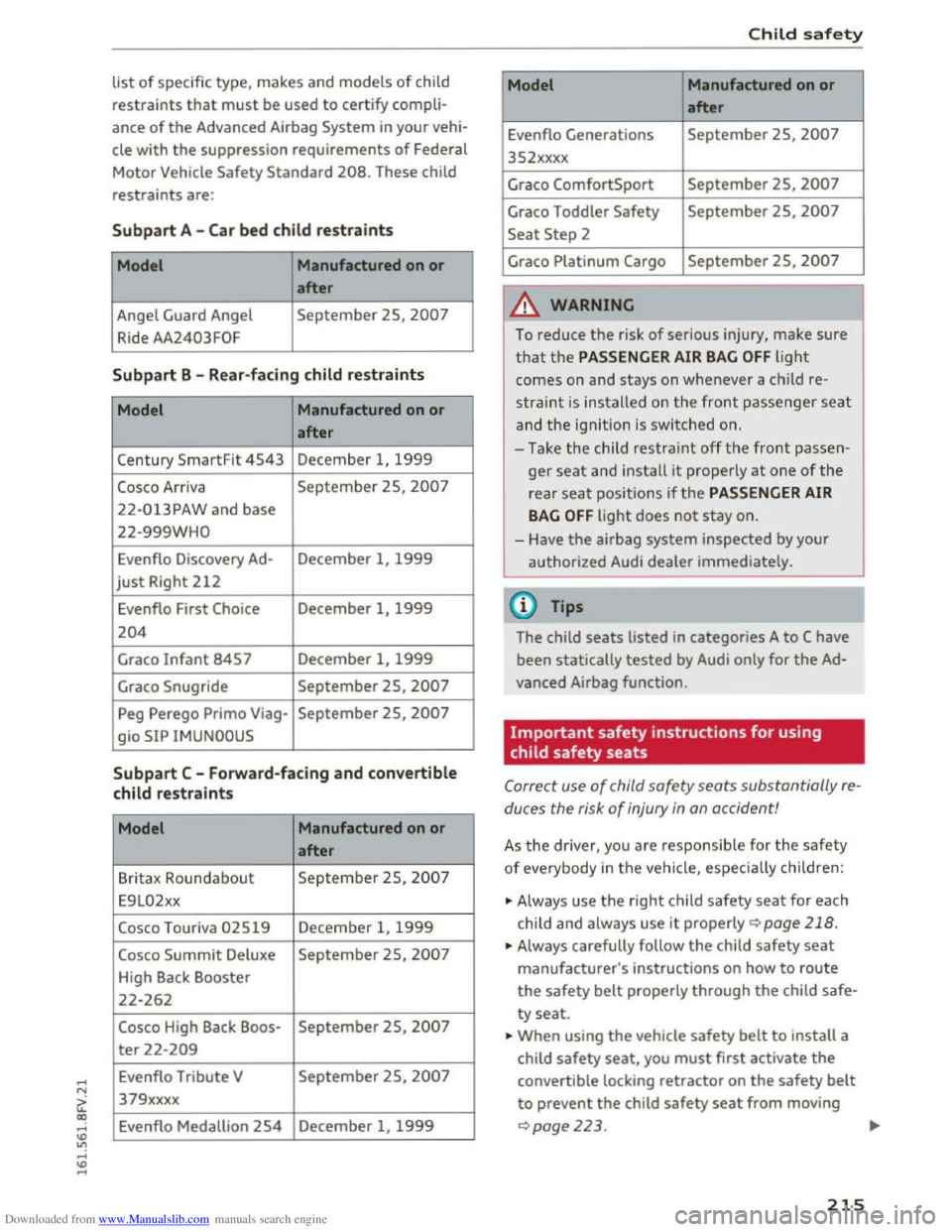
Downloaded from www.Manualslib.com manuals search engine ...... N
> u. CX> ...... u:>
"' ..... u:> .....
list of specific type, makes and models of child
restraints that must be used to certify compli
ance of the Advanced Airbag System in your vehi
cle with the suppression requirements of Federal
Motor Vehicle
Safety Standard 208. These child
restraints are:
Subpart A -Car bed child restraints
Model Manufactured
on or
after
Angel Guard Angel September 25, 2007
Ride AA2403FOF
Subpart B -Rear-facing child restraints
Model Manufactured
on or
after
Century SmartFit 4543 December 1, 1999
Cosco Arriva September 25, 2007
22-013PAW and base
22-999WHO
Evenflo Discovery Ad-December 1, 1999
just Right 212
Evenflo First Choice December 1, 1999
204
Graco Infant 8457 December 1, 1999
Graco Snugride September 25, 2007
Peg Perego Primo Viag-September 25, 2007
gio SIP IMUNOOUS
Subpart C -Forward -facing and convertible
child restraints
Model Manufactured on or
after
Britax Roundabo ut September 25, 2007
E9 L02xx
Cosco Touriva 02519 December 1, 1999
Cosco Summit Deluxe September 2S, 2007
High Back Booster
22-262
Cosco High Back Boos-September 2S, 2007
ter 22-209
Evenflo Tribute V September 25, 2007
379xxxx
Evenflo Medallion
254 December 1, 1999
Child safety
Model Manufactured on or
after
Evenflo Generations September 25, 2007
352xxxx
Graco
ComfortSport September 25, 2007
Graco Toddler Safety September 25, 2007
Seat Step 2
Grace
Platinum Cargo September 25, 2007
A WARNING
i-=--
To reduce the r isk of serious injury, make sure
that the PASSENGER AIR BAG OFF light
comes on and stays on whenever a child re
stra int is installed on the front passenger se a t
and the ignit ion is switched on.
- T ake
the child restraint off th e front passen
ger seat and install it properly at one of the
rear seat positions if the PASSENGER AIR
BAG OFF light does not stay on.
- Have
the airbag system inspected by your
a u
thorized Audi dealer immediately.
been statically tested by Audi only for the Ad
vanced Airbag function.
Important safety instructions for using
child
safety seats
Correct use of child safety seats substantially re
duces
the risk of injury in an accident!
As the driver, you are responsible for the saf e ty
of eve rybody in the vehicle, especially c hildre n:
.,. Always use the right child safety seat for each
child
and always use it properly i:> page 218.
.,. Always carefully follow the child safety seat
manufacturer's instructions on how to route
the safety belt properly through the child safe
ty seat.
.. When using the vehicle safety belt to install a
child
safety seat, you must first activate the
convertible locking retractor on the safety belt
to prevent the child safety seat from moving
i:>page223. Iii>
215
Page 218 of 322
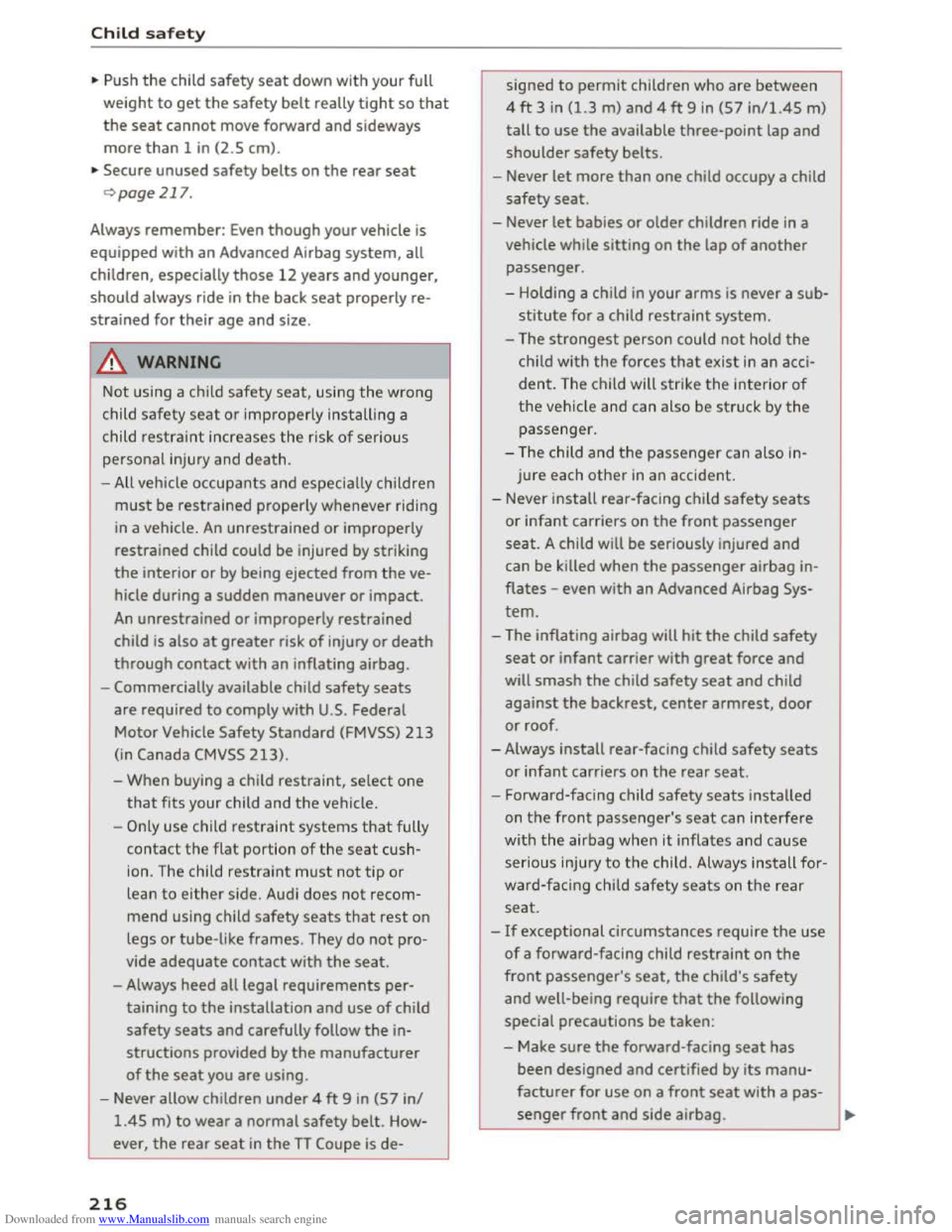
Downloaded from www.Manualslib.com manuals search engine Child safety
.,. Push the child safety seat down with your full
weight to get the safety belt really tight so that
the seat cannot move forward and sideways
more than 1 in (2 .5 cm) .
.,. Secure unused safety belts on the rear seat
c>poge 217.
Always remember: Even though your veh icle is
equipped w ith an Advanced Airbag system, all
children, especially
those 12 years and younger,
should always ride in the back seat properly re
strained for their age and size.
A WARNING
Not using a child safety seat, using the wrong
child safety seat or improperly installing a
child
restraint increases the risk of serious
personal injury and death.
-All vehicle occupants and especially children
must be restrained properly whenever riding
in a vehicle. An unrestrained or improperly
restrained child could be injured by striking
the interior or by being ejected from the ve
hicle during a sudden maneuver or impact.
An unrestrained or improperly restrained
child is also at greater risk of injury or death
through contact with an inflating airbag.
- Commercially available child
safety seats
are required to comply with U.S. Federal
Motor
Vehicle Safety Standard (FMVSS) 213
(in Canada CMVSS 213).
-When buying a child restraint, select one
that fits your child and the vehicle.
- Only
use child restraint systems that fully
contact the flat portion of the seat cush
ion. The child restraint must not tip or
lean to either side. Audi does not recom
mend using child safety seats that rest on
legs or tube-like frames. They do not pro
vide adequate contact with the seat.
-Always heed all legal requirements per
taining to the installation and use of child
safety seats and carefully follow the in
structions provided by the manufacturer
of the seat you are using.
- Never allow children
under 4 ft 9 in (57 in/
1.45 m) to wear a normal safety belt. How
ever, the rear seat in the TT Coupe is de-
216
signed to permit children who are between
4 ft 3 in (1.3 m) and 4 ft 9 in (57 in/1.45 m)
tall to use the available three-point lap and
shoulder safety belts .
- Never
let more than one child occupy a child
safety seat.
- Never let babies or older children ride in a
vehicle while
sitting on the lap of another
passenger.
-Holding a child in your arms is never a sub
stitute for a child restraint system.
- The strongest person could not hold the
child with the forces that exist in an acci
dent. The child will strike the interior of
the vehicle and can also be struck by the
passenger.
-The child and the passenger can also in
jure each other in an accident.
- Never
install rear-facing child safety seats
or infant carriers on the front passenger
seat. A child will be seriously injured and
can be killed
when the passenger airbag in
flates -even with an Advanced Airbag Sys
tem.
-The inflating airbag will hit the child safety
seat or infant carrier with great force and
will smash the child safety seat and child
against the backrest, center armrest, door
or roof.
- Always install
rear-facing child safety seats
or infant carriers on the rear seat.
- Forward-facing child
safety seats installed
on
the front passenger's seat can interfere
with the airbag when it inflates and cause
serious injury to the child. Always install for
ward-facing child safety seats on the rear
seat.
-If exceptional circumstances require the use
of a forward-facing child restraint on the
front passenger's seat, the child's safety
and well-being require that the following
special
precautions be taken:
- Make sure the forward-facing seat has
been designed and certified by its manu
facturer for use on a front seat with a pas-
senger front and side airbag. Ill>
Page 219 of 322

Downloaded from www.Manualslib.com manuals search engine ..... N
G: CX)
.....
"' U"I
.....
"' .....
-Always carefully follow the manufacturer's
instructions provided with the child safety
seat or carrier.
- Always move
the front passenger seat into
the rearmost position of the passenger
seat's fore and aft adjustment range, and
as far away from the airbag as possible be
fore installing the child restraint.
- Always make sure that nothing prevents
the front passenger's seat from being
moved
to the rearmost position in its fore
and aft adjustment range.
- Always make
sure that the backrest is in
the upright position.
- Never place or use any
electrica l dev ice
(such as a laptop,
CD player, electron ic
games device, power inverter or seat heat
er for child seats) on the front passenger
seat ifthe dev ice is connected to the 12-
volt socket or the cigarette lighter socket.
- If a
seat heater has been retrofitted or
otherwise added to the front passenger
seat, never install any child restraint sys
tem on this seat.
- Make
sure that there are no wet objects
(such as a wet towel) and no water or oth
er liqu ids on the front passenger seat
cushion.
- Never place objects on
the seat (such as a
laptop,
CD p layer, electronic games de
vice, power inverter or seat heater for
child
seats). These may influence the elec
trical capacitance measured by the capaci
tive passenger detection system and can
also fly
around in an accident and cause
serious
personal injury.
- Always buckle
the child safety seat firmly in
place even if a child
is not sitting in it. A
loose child
safety seat can fly around during
a
sudden stop or in a collision.
- Always read
and heed all WARNINGS when
ever using a child restrained in a vehicle is
being used c::> page 180, Safety belts,
c::> page 188, Airbag system and
c::>page 212, Child safety.
Child safety
A WARNING
f=
To reduce the risk of serious injury, make sure
that th e PASSENGER AIR BAG OFF light
comes on and stays on whenever a child re
straint is installed on the front passenger seat
and the ignit io n is switched on.
- Take
the child restra int off the front passen
ger seat and install it prope rly at one of the
rear seat positions if the PASSENGER AIR
BAG OFF light does not stay on.
- Have
the airbag system inspected by your
authorized Audi dealer immed iately.
Secure unused safety belts on the rear seat
Fig. 165 Schematic overview : keep unused safety belts
away from ch
ildren in child safety seats. -outer rear safety
belt,
If a child safety seat is used on the rear bench,
especially with
LATCH universal lower anchorag
es, the unused safety belts must be sec ured so
that the child in the c hild restraint cannot reach
them c::> .&..
-Fasten the unused safety belt behind the child
seat and let the belt retractor wind up the safe
ty belt webbing.
A WARNING
A child in a chi ld safety seat installed with the
LATCH lower anchorages or with the s tandard
safety belt or a child in a booster seat on the
rear seat could play with unused rear seat
safety belts and become entangled. This
could cause
the child serious personal injury
and even death.
-Always secure unused rear seat safety belts
out of reach of children in child seats such
217
Page 220 of 322

Downloaded from www.Manualslib.com manuals search engine Child safety
as by fastening the unused safety belt be
hind the child seat and letting the belt re
tractor wind up the webbing.
Child seats
Infant seats
Babies and infants up to about one year old and
20 lbs or 9 kg need special rearward-facing child
restraints
that support the back, neck and head
in a crash.
Fig. 166 Schemat ic overview : rearward -facing infant seat,
properly installed on the rear seat
"'When using the veh icle safety belt to install a
child
safety seat, you must first activate the
convertible locking retractor on the safety belt
to prevent the child safety seat from moving
9page 223.
"'Push the child safety seat down with your full
weight to get the safety belt really tight so that
the seat cannot move forward and sideways
more than 1 in (2.5 cm).
"'Secure unused safety belts on the rear seat
9page 217.
Infants up to about one year (20 lbs or 9 kg) are
best protected in specia l infant carriers and child
safety seats designed for their age group. Many
experts believe that infants and small children
should ride only in special restraints in which the
child faces the back of the vehicle. These infant
seats support the baby 's back, neck and head in a
crash 9fig. 166.
The airbag on the passenger side makes the front
seat a potentially dangerous place for a child to
ride. The front seat is not the safest place for a
child
in a forward-facing child seat. It is a very
218
dangerous place for an infant or a larger child in
a rearward-facing seat.
A WARNING
Not using a child safety seat, using the wrong
child safety seat or improperly installing a
child
restraint increases the risk of serious
personal injury and death in a crash.
- Never install rear-facing child
safety seats
or infant carriers on the front passenger
seat -even with an Advanced Airbag System.
A child will be seriously injured and can be
killed when the inflating airbag hits the
child safety seat or infant carrier with great
force and smashes the child safety seat and
child
against the backrest, center armrest,
door or roof~ page 189, Child restraints on
the front seat -some important things to
know.
-Always install rear-facing chi ld safety seats
or infant carriers on the rear seat.
-Never install a rear-facing child restraint in
the forward-facing direction. Such restraints
are designed for the special needs of infants
and very small children and cannot protect
them properly if the seat is forward-facing.
-
If you must install a rearward facing child
safety seat on the front passenger seat be
cause of exceptional circumstances and the
PASSENGER AIR BAG OFF light does not
come on and stay on, immediately install
the rear-facing child safety seat in a rear
seating position and have th e a irbag system
inspected by your Audi dealer.
- Never pl
ace or use any electrical device
(such
as a laptop, CD player, electronic
games d evice, power inverter or seat heater
for child seats) on the front passenger seat
if the device is connected to the 12-volt
socket or the cigare tte lighter socket.
-
If a seat heater has been retrofitted or oth
erwise added to the front passenger seat,
never install any child restraint system on
this seat.
-Make sure that there are no wet objects
(such as a wet towel) and no water or other
liquids on the front passenger seat cushion. ..,.